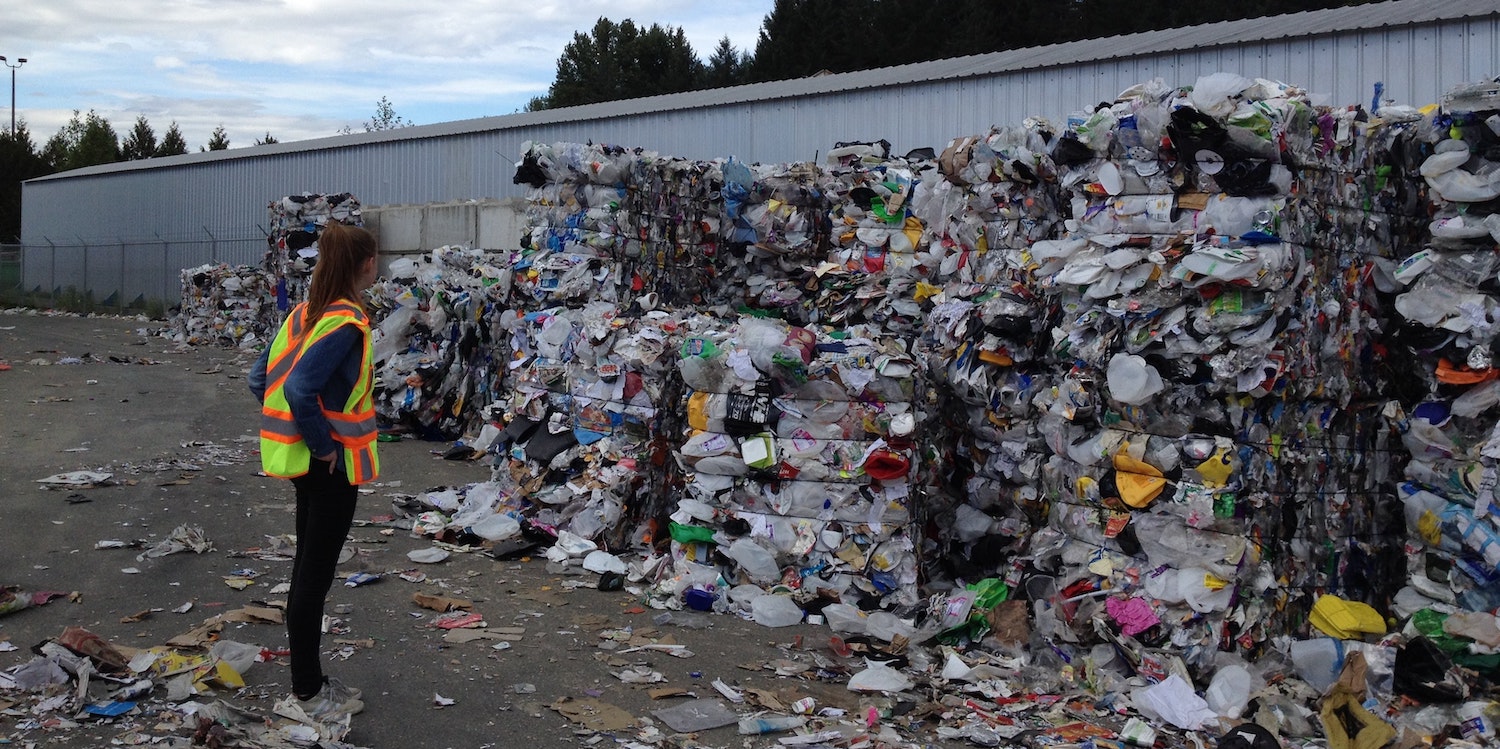At this point, it’s no secret – we love our recycling.
But once we’ve dropped our items into the recycling bin, most of us don’t stop to think about where they go. We’ve done our part – from there, someone else picks up the torch, right?
But recycling is more than just a bin in your kitchen. It’s a global, billion-dollar industry.
And you may have heard little whispers that the recycling industry is broken. That somewhere along the way, recycling went wrong. But what, exactly, happened?
Today, we’re breaking down how the recycling industry works, what happened when the recycling industry crashed, and what’s needed now to fix it. So, are you ready to learn the truth about recycling?
Let’s get into it.
The Recycling Industry Crash – What Happened?
When recycling first picked up in the 60-70s, we were all pretty good at it. People knew how to sort their trash, to rinse the packaging, and what not to put in the recycling bin. Recycling was new, but it was working pretty well.
When production boomed in China, they needed lots of materials to feed their fast-paced factories. To solve this, they began importing other countries’ recyclables. This was a massive shift for the recycling industry – not just in the US, but for Europe as well. For decades, China bought and handled almost half of the entire world’s recycling.
Then, single-stream recycling was introduced. Suddenly, all recyclables went into the same bin, rather than into separate ones as before.
In 2016, the US exported 16 million tons of paper, metals, and plastic to China. But 30% of it couldn’t actually be recycled.
As you can probably guess, this was another big shift in the industry. It made it much easier for individuals to take part in recycling, so more people did. The amount of trash recycled grew – but with mixed materials also came contamination.
In 2016, the US exported 16 million tons of paper, metals, and plastic to China. But 30% of it couldn’t actually be recycled, because the batches were too contaminated by food scraps and non-recyclables. And what happened to all those batches?
You guessed it – landfill, incineration, and trash pollution.
Each year, between 1.3 – 1.5 million metric tonnes entered the seas from China’s coasts. And that's without mentioning all the pollution of their countryside and smaller waterways.
So in 2018, China’s environmental laws tightened. They banned the import of any recycling batches that were more than 1.5% contaminated. With single-stream recycling firmly in place for years and contaminated rates so high... Well, most batches couldn’t meet this standard. Suddenly, the millions upon millions of recyclables collected in the West each year had nowhere to go.
Cue the Recycling Industry crash.
Consequences of the Recycling Industry Crash

After China’s ban, the US turned to other South-East Asian countries, exporting to Thailand, Vietnam, Malaysia. When their laws tightened too, we turned to Cambodia, Bangladesh, Kenya, Ethiopia... But they were already overwhelmed with contaminated trash they could do nothing with.
Even today, the US exports over a million metric tons of trash each year –and 20-70% of it is actually too contaminated to be useful. And it's not without consequence. Crop death, contaminated water, respiratory illnesses, and organized crime... Studies have connected exported recyclables with all of them.
Looking at the environmental cost of all these transports, and the harm the contaminated batches are doing to communities… Well. It’s safe to say that the recycling industry wasn’t working before the crash, either. In some ways, the crash in 2018 was the emergency brake finally getting pulled.
But years later, the recycling industry is still on its knees. So what, exactly, are the problems facing the U.S. recycling industry today?
Challenges in the U.S. Recycling Industry
For decades, the West relied on China and other South-East Asian countries' imports. And so, their own recycling industries never fully developed. There was no real market for recyclable material in their own countries, and so the recycled material just... sat there.
But there are many benefits to countries closing the recycling loop on their own. For one, it would drastically cut the transportations of millions of batches per year. It would also ensure that recycled material is actually put to use. And of course – it would help ensure that similar crashes don't happen again.
When no one’s buying recycled materials, there’s no money to fund the running of recycling facilities.
So the main concern now is, how do we make the U.S. recycling industry self-sufficient? How do we build it up?
To that end, there are three main problems facing the US recycling industry today. Let's have a look at them:
1. Economics
It’s simple math, really. When no one’s buying recycled materials, there’s no money to fund the running of recycling facilities. And since the U.S. has been exporting recyclables for so long, there’s no real internal market for recycled materials.
After the crash, over 70 centers nationwide were forced to shut down. They simply couldn’t run anymore – although public protests brought some of them back. Even more centers had to limit their services or up their prices to survive and cover their costs.
And today, recycling has to compete for funding with public schools, policing, and more. Not surprisingly, it often loses – and so the recycling industry continues to bleed.
2. No Federal Recycling Structure
There’s also no central body streamlining recycling nationwide. In other words... Over 20,000 communities across the country operate under their own rules, deciding for themselves what and how to recycle.
This, of course, makes building up the national recycling infrastructure very complicated. Investors in different areas have varying stakes and interests. More often than not, they end up working against each other, rather than together. And yet, those investments are crucial to the survival of the industry.
Today, over 20,000 communities across the country operate under their own rules, deciding for themselves what and how to recycle.
Luckily, we had some great news last year, in November 2021. For the first time ever, the Environmental Protection Agency (EPA) put forth a national recycling strategy. It's the first step in a new plan for a more circular economy – and the first goals are set for the end of this decade. Yay for progress!
3. Problems with Single-Stream Recycling
As you can tell, one of the root causes of the problems in the recycling industry is contaminated batches.
And the truth is, while it’s easier for us to toss everything in one bin... Most of us have forgotten how to recycle correctly or never actually learned. Every day, thousands of people toss things in the bin just hoping they're recyclable. And it’s one of the main reasons recycling fails.
Many batches are so contaminated that they can’t actually be safely sorted, or sorted at all. This means unnecessary waste, since even recyclable items end up in landfill.
Besides, mixed recyclables are more complicated and costly for centers to sort through. On top, mixed recyclables generally sell for less per batch – which means more economic losses.
All of this, while the global market for high-quality recycled materials is actually growing. So, what can be done to solve these issues?
Solutions to Recycling Problems – What Can Be Done?
Now, don’t worry – it’s not over for recycling quite yet. There are still things that can be done to solve our recycling problems and get the industry back on its feet.
But we need to strengthen our infrastructure so that the US market can close its own loop. Recovering, recycling, and buying materials, all within the country itself. That way, the money generated by the industry would go back into the industry.
Like a self-sufficient, well-lubricated machine.
But for that, to join forces across state lines, and we need real investments. With common goals and rules across the nation, we could start to get somewhere.
Investments could then improve the equipment of recycling centers across the country. Both recovery, sorting and the recycling process itself could become safer and more efficient. Fewer batches would end up in landfill, while more would generate money.
We need to strengthen our infrastructure so that the US market can close its own loop.
This is why the EPA’s new plan for a national recycling strategy is so exciting. Hopefully, in the coming years, we’ll start to see the results.
As a bonus, if recycling was streamlined across the nation, it would be easier to educate around recycling. What gets recycled would be virtually the same, no matter where you’re based. And if good information on how to recycle right was readily available and easy to share? It would most likely mean less contamination of pure batches.
We also need to create a need for recycled materials within the US. Today, many companies are skeptical of buying recycled materials. In part, because it has a rumor for often being low-quality due to contamination, but also because of pricing. Hopefully, with higher-quality material coming out of facilities, this will begin to change.
If recycling was streamlined across the nation, it would be easier to educate around recycling.
But more initiatives than that are needed in the long run. In the past, when cities and institutions demanded that a percentage of what they buy be made from recycled materials, it's made a huge difference.
First, educate ourselves and those around us about how to recycle right. The less contamination, the better – and it's all in the hands of consumers.
Second, keep buying items made from recycled materials. This helps to create a demand for recycled products, and signals that we think it's important. In the long run, it might even help sway laws and regulations!
Solutions Beyond Recycling
But as fantastic as recycling is, we also have to swallow a hard truth – recycling alone was never meant to save the planet. In fact, there’s a reason recycling is last in the eco-warrior’s holy trinity: reduce, reuse, recycle.
Most materials can only be recycled so many times, and alongside all this recycling we’re doing? Raw materials are still getting produced all the time.
That’s not to say we shouldn’t recycle – we absolutely should. But as David Ayer, the Campaign leader for Earth Day’s End Plastics Pollution said: If you came home and the sink was overflowing, you wouldn’t grab a mop – you’d turn off the water.
In our quest to do good, we’ve begun relying on recycling to solve everything. And engaging with recycling and recycled products are great actions to take for the planet.
But the emphasis on recycling shifts the focus away from big companies and corporations, and onto us as individuals.
And feeling like it's our responsibility to solve this crisis on our own? That's a heavy weight to carry. And as you can tell, with recycling it's not true. There’s a lot of change that needs to happen on a national and even global level.
So, continue reducing, reusing, and recycling – in that order. The fewer items you have to put toward recycling, the better. But remember… it’s not all on your shoulders. You’re doing good.
And that’s it for this post! What’s the most surprising thing to you about how recycling works? Share with us in the comments below!
Psst… Eager to learn more? Check out our post about Wishcycling, to learn how to recycle the right way!






